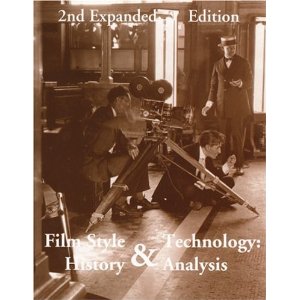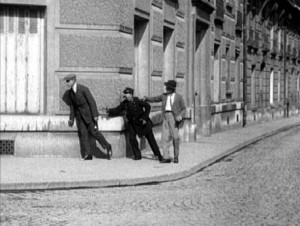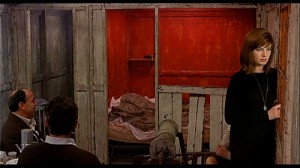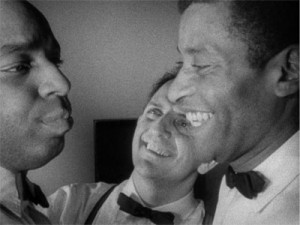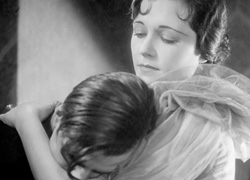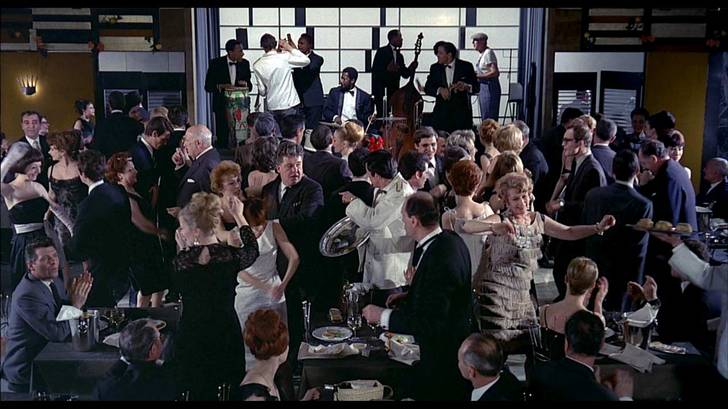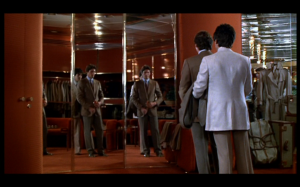From Wide Angle, vol. 8, no. 3-4, 1986. –- J.R.
FILM STYLE AND TECHNOLOGY:
HISTORY AND ANALYSIS by Barry
Salt, Starword, 3 Minford Gardens,
London W14 0AN, England, 1983:
paper, $ 15.00, 408 pages, lllustrations
It is a sad commentary on the
narrowness and inflexibility of current
academic publishing in film studies
that this major work had to be brought
out at the author’s own expense.
Handsomely produced and generously
priced, Film Style and Technology:
History and Analysis offers what is
conceivably the most detailed account
of film technology that we have had to
date, stretching from 1885 through the
Seventies, with roughly one chapter per
decade, and for this aspect of the book
alone, no comprehensive library devoted
to film history can afford to be without it.
In addition, the book’s innovative use of
statistical style analysis, while
problematical in relation to certain stylistic
issues, nevertheless introduces a new form
of rigor to film analysis that deserves to be
considered in detail.
If, as a “total” view of cinema, Salt’s approach
often seems constricted, it nonetheless yields
a wealth of potentially useful material to many
different kinds of film scholars. As Salt’s title
makes clear, a technological history of film
represents only one part of his enterprise. The
historical development of film style, seen chiefly
through the historical development of film
technology, would be a more accurate
definition of his subject -– an extraordinarily
ambitious undertaking — and it is largely here
that Salt has attracted the most controversy.
Describing his intellectual position as Scientific
Realism, “[which] can be crudely summarized
as the view that there is a real world, and that
this real world is described by the established
natural sciences,”
Salt is concerned with establishing an objective.
precision to his work which is clearly at odds
with both impressionistic criticism and much of
the speculative film theory that has dominated
film studies up to the present. The virtual solitude
oi Salt in relationship to the contemporary scene
has a lot to do with what makes him provocative
and valuable, regardless of whether or not one
sympathizes with his aims; whatever he’s piping,
it’s not the same old tune. Speaking as a journalist
and academic who has often championed self-
declared (as opposed to unacknowledged)
subjectivity as a potentially liberating force —
and who tends to value theory, criticism and
history alike as material to be scavenged for
possible insights rather than as self-generated
activities desirable as ends in themselves — I
approached Salt’s book with some caution and
misgivings, and continue to regard it with a
certain ambivalence, in spite of its unquestionable
achievements. Without being qualified to confirm
or challenge Salt in most of his factual assertions,
I have a natural suspicion towards any historian
who claims to know the “first” time a particular
usage occurs in the cinema, at least when such a
usage is not wholly dependent on a new
development in technology, and the three
examples below point to some of the possible
confusions that can lead from such assertions:
As far as using optical printing for
reversing action and producing “freeze
frames”is concerned, the important film
seems to have been Hollywood (James
Cruze, (1923), but a much better-known
example where the effects of these
techniques are central to the plot is René
Clair’s Paris Qui Dort (1924 ). These
devices, though continuing to appear
intermittently in lighter films, were never
used in serious dramas till the nineteen-
sixties. (p. 206)
Michelangelo Antonioni was another film-
maker important for his use of long focal
length lenses in ll Deserto Rosso (1964
In his case he was interested in them as a
means of producing near-abstract
compositions of hard-edged areas
of flat colour, and a large proportion of
in ll Deserto Rosso was shot with lenses
of focal length from 100mm upwards.
As far back as La Notte (1961), Antonioni
had been creating compositions influenced
by the school of “hard-edged” abstract
painting descended from Barnett Newman (
an Italian representative was Bruno
Marani), though initially he had done this
with standard-lens cinematography. This was
the first time since the nineteen-twenties that
the advanced painting of the recent past had
an influence on film image composition. (336)
Cassavetes‘ Shadows was original in that it
was created largely through guided group
improvization [sic] , and this has remained
Cassavetes’ practice ever since in his low-
budget films… (347)
In each case, Salt begins with a
commonsensical assertion that then
becomes problematical as soon as he tries
to make too much out of it. The freeze-frames
that occur in such serious dramas as It’s a
Wonderful Life (1946) and at the end of All
About Eve (1950) throw some doubt on the last
sentence in the first quotation.
Regarding the last sentence quoted on Antonioni,
one doesn’t even need a contrary example to
question whether Salt could possibly assert that
over 30 years of commercial filmmaking, “film
image composition” was never — presumably
not even once — influenced by “advanced painting
of the recent past.” (How could any historian claim
to know this?) Regarding Cassavetes, further
research would reveal that the practice of group
improvisation played a substantial role only
in his first feature; in a recent feature like
Love Streams (1984), according to several
accounts, improvisation occurs significantly
only in a single scene (Gena Rowlands
trying to amuse her family beside a swimming
pool.)
Ironically, it is Salt’s own call for precision that
makes such relative imprecisions stand out. (On
the whole, he is a good deal more cautious.) More
generally, as a corrective and challenge to film
studies as they are presently constituted, his
methodology is like a strong tonic, and I have
few misgivings about Salt’s frontal assault on
fashionable film theories in his first five
chapters –- which, according to his Preface, is
what led to his book as a whole being rejected by
American academic presses. Unlike he more long-
winded and self-regarding disparagements of
Continental theory that have recently become à la
page in the more apolitical reaches of academia
(as in the work of David Bordwell and Noel Carroll),
Salt’s objections to many of the same theorists are
pithy, pungent and existentially sound in relation
to his own sphere of interest, and there is little
sense of grandstanding in the way that Salt
delivers them.
My objections to Salt, then, have little to do with
his dismissals of Metz, Heath, Eco, Althusser,
Lacan et al — although one might note in passing
that the refusal of the academic world to deal with
his arguments has probably brought a certain
stridency to his tone. What seems more troubling
to the reader is Salt’s overall conception of film
style –- a conception that is in some respects
inseparable from his methodology, but in other
respects demands to be viewed quite
independently of it. Although Salt never
precisely equates devices, effects and equipment
with aesthetic strategies, his working assumption
that style is quantifiable nonetheless leads him
in that general direction, and there are times
when he appears to be more concerned with
“styling” (as in the way cars are built –- how
much chrome, the size of the fins, etc.) than
with style per se, and more with equipment and
statistics than with art. This is not to deny that his
statistical tables, regarding shots scales, shot
durations, reverse angles and camera movements
in large numbers of films are germane to
discussions of style, only to suggest that how and
when they are germane is not a question that is
always happily resolved. The facts that, say,
Ophuls’Liebelei (1932) contains 100 pans and
that Lola Montès (1955) contains 52 pans, 9
cranes, 54 tracks with pans and tilts, 62 tracks
with pans, 19 tracks, 19 pans with tilts, and 8
tilts may or may not be useful, but surely the
pertinence of any one of these camera
movements is more important than
any of the above; and it is on questions of
pertinence that Salt most often leaves one
hanging.
In the final analysis., then, Salt’s
findings mav be more relevant as a
checkpoint against the factual abuses
of other scholars than as an aesthetic
topography which is satisfying in its
own right. It is fascinating to read
Salt’s account of the method of interior
lighting in Godard’s Le petit soldat
(1960), and frustrating to find that in all
his detailed accounts of jump-cuts he
fails to mention A bout de souffle (1959)
even once. Similarly, to remain in the
chapter on the Sixties which has provided
most of the examples here, it is pleasing to
see Tati’s Playtime (1967) acknowledged as
the “only film to begin to develop a new
form out of the special properties of 70mm film,”
and infuriating to see Salt short-change this
same achievement by coming up with a
reductive and objectively inaccurate
description like the following:
Despite the claims made by some people that the separate actions in different parts of the frame actually involve different simultaneous comic interests, calm viewing of the film shows that this is not so, and that there is only one point of narrative or comedy interest going on at any one instant, in just one area of the frame. The rest of the action is really just background distraction which makes it a little difficult to find where the main point of interest lies.
Arguably, if “calm viewing” entails a refusal to laugh and a concerted lack of interest in all narrative detail that detracts from a central thread, Salt’s misreading might indeed be defensible as Scientific Realism, even if Tati’s genius gets lost in the shuffle; but what is gained in such an exercise? On a somewhat related plane, considering the fact that Robert Bresson’s name doesn’t figure once in Salt’s index, it perhaps isn’t unduly surprising to find him label Being There (1979) and American Gigolo (1980) as films of “high artistic ambition”.
But even after airing all these qualms,
my description of Salt’s book as
indispensable still, stands. It might
sound like a backhanded compliment
to say that this book deserves to be
used and consulted as one uses
Leonard Maltin’s TV Movies -– as a
cross-reference and source of additional
information rather than as a primary text
— but in fact, given the many practical uses
of Maltin, it is nothing of the sort. A Martian
who wanted to learn about the cinema and
stumbled upon Film Style and Technology
might be dissuaded by such a book from
delving into the subject any further, but any
self-respecting Martian – or film professor –
who uses it as a backup source will be amply
rewarded.

